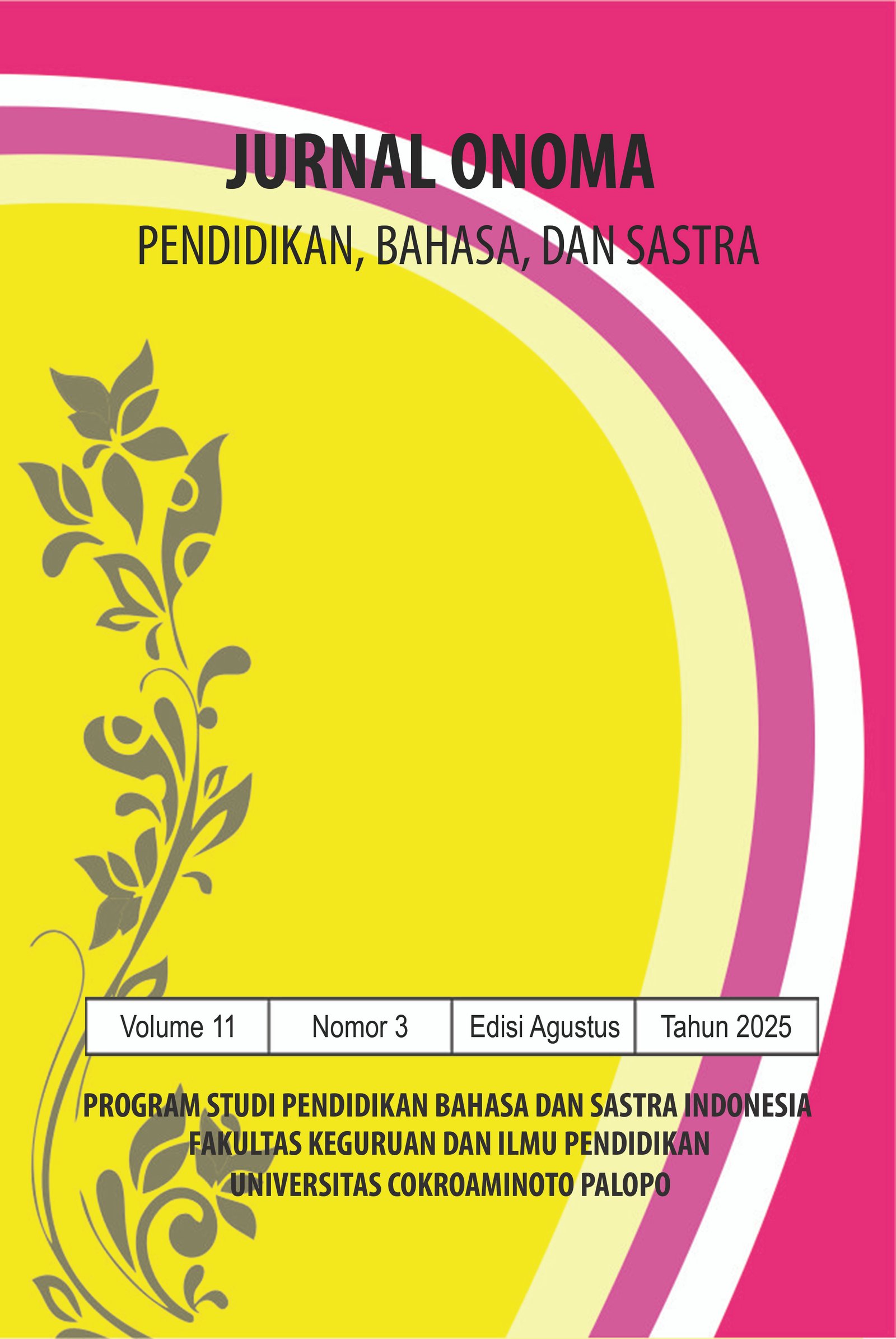Segmental English Phonemes In NF’s Rap Song Story: Exploring Type And Rule
https://doi.org/10.30605/onoma.v11i3.6727
Keywords:
phoneme, phonological rules, assimilation, deletion, dissimilationAbstract
This study aims to identify phonemes’ changing in NF rap song, in terms of the types of phonological rules in vowels and consonants; assimilation, dissimilation, and deletion. Furthermore, this study figures out how these phonological rules are formed. The rap song Story NF is chosen as the object study in terms of research on phoneme analysis in rap song is still limited. This research applied a qualitative approach. This research employs Lass' (1984) theory as the main theory to analyze data. The data found fifty cases which consist of six regressive assimilation, nine progressive assimilation, four fusional assimilation, two dissimilation, and thirty-three deletion processes. They consist of twenty-two aphaeresis, four syncope, and seven apocope. The findings show that progressive assimilation is the most frequently applied process from the assimilation aspect. At the same time, aphaeresis is the most commonly used process in the deletion aspect, highlighting how connected speech is naturally formed to adapt to the rhythm-driven nature of rap music. All of this connected speech occurs because of rapid speech.
Downloads
References
Al-Nabhani, S., & Madiseh, F. R. (2025). a Phonological Analysis of Efl Learners’ Speech: Implications for Effective Pronunciation Instruction. Journal of Teaching English for Specific and Academic Purposes, 13(1), 101–118. https://doi.org/10.22190/JTESAP250105009A DOI: https://doi.org/10.22190/JTESAP250105009A
Amalia, V. K., & Supri, I. Z. (2024). Contractions and Phonological Process in the Album ‘Mezmerize’ and ‘Hypnotize’ By System Of A Down Bad. English Journal Literacy Utama, 2018, 64–72. DOI: https://doi.org/10.33197/ejlutama.v8i1.244
Bedu, A. (2024). Generative Approach to African linguistics and Literary Studies: A Festschrift in Honour of Professor Mohammed Munkaila (A. M. Bedu & B. Usman (eds.)). Faculty of Arts, University of Maiduguri Occasional.
Birjandi, P., & Salmani-Nodoushan, M. A. (2005). An Introduction to Phonetics. Distributed by ERIC Clearinghouse.
Creswell, J. W., & Creswell, J. D. (2018). Research Design: Qualitative, Quantitative, and Mixed Methods Approaches. SAGE Publications. https://books.google.co.id/books?id=s4ViswEACAAJ
Diani, M. (2018). Connected Speech Aspect of Elision in the World of Our Own Album By Westlife Phonologically. Sekolah Tinggi Ilmu Bahasa Asing - JIA.
Firdhani, A. R., Maulia Indrayani, L., & Mahdi, S. (2018). The Use Of Consonant Elision By Sri Mulyani During Her Interview Session With The Banker. ELTIN Journal, 6(2), 53–58. DOI: https://doi.org/10.22460/eltin.v6i2.p53-58
Gussenhoven, C., & Jacobs, H. (2017). Understanding Phonology. In Understanding Phonology (Fourth Edition). Routledge. https://doi.org/10.4324/9781315267982 DOI: https://doi.org/10.4324/9781315267982
Hatimah, Zannah, H., & Rosidah. (2022). English Phonological Rules in The Movie of Not Cinderella’s Type (2018). Sketch Journal: Journal of English Teaching, Literature and Linguistics, 2(1).
Ilxomovna, S. R., & Rustam, J. G. (2024). Role of Phonetics in Learning English. 228–231. https://doi.org/10.2024/0e47fm47
Kothari, C. R. (2004). Research Methodology; Methods and Techniques (2nd Revised Edition). New Age International.
Lass, R. (1984). Phonology: An Introduction to Basic Concepts. 1–361. DOI: https://doi.org/10.1017/S0952675700000300
Ndaalu, A.-N. H., & Ngulube, I. E. (2024). English Phonological Operations: A Study of Rule Interactions. International Journal of Literature, Language and Linguistics, 7(1), 1–48. https://doi.org/10.52589/ijlll-td0jp8vb DOI: https://doi.org/10.52589/IJLLL-TD0JP8VB
Patel, A. D., & Iversen, J. R. (2021). Processing rhythm in speech and music: Shared mechanisms and implications for phonological restructuring. Frontiers in Psychology, 12, 678901. https://doi.org/10.3389/fpsyg.2021.678901
Roach, P. (2013). English Phonetics and Phonology A practical course A practical course. www.cambridge.org
Skandera, P., & Burleigh, P. (2005). A Manual of English Phonetics and Phonology. 1–151.
Wulandari, A. A., Ketut, N. L., Indrawati, M., Made, N., & Widiastuti, A. (2023). A Phonological Analysis Of Elision Found In SZA’S Selected Songs In ‘SOS’ Album. International Journal of Linguistics and Discourse Analytics, 5(1). DOI: https://doi.org/10.52232/ijolida.v5i1.83
Downloads
Published
How to Cite
License
Copyright (c) 2025 Bachtiar Abdullah, Lida Holida Mahmud

This work is licensed under a Creative Commons Attribution 4.0 International License.
In submitting the manuscript to the journal, the authors certify that:
- They are authorized by their co-authors to enter into these arrangements.
- The work described has not been formally published before, except in the form of an abstract or as part of a published lecture, review, thesis, or overlay journal.
- That it is not under consideration for publication elsewhere,
- That its publication has been approved by all the author(s) and by the responsible authorities – tacitly or explicitly – of the institutes where the work has been carried out.
- They secure the right to reproduce any material that has already been published or copyrighted elsewhere.
- They agree to the following license and copyright agreement.
License and Copyright Agreement
Authors who publish with Onoma Journal: Education, Languages??, and Literature agree to the following terms:
- Authors retain copyright and grant the journal right of first publication with the work simultaneously licensed under Creative Commons Attribution License (CC BY 4.0) that allows others to share the work with an acknowledgment of the work's authorship and initial publication in this journal.
- Authors are able to enter into separate, additional contractual arrangements for the non-exclusive distribution of the journal's published version of the work (e.g., post it to an institutional repository or publish it in a book), with an acknowledgment of its initial publication in this journal.
- Authors are permitted and encouraged to post their work online (e.g., in institutional repositories or on their website) prior to and during the submission process, as it can lead to productive exchanges, as well as earlier and greater citation of published work.

















